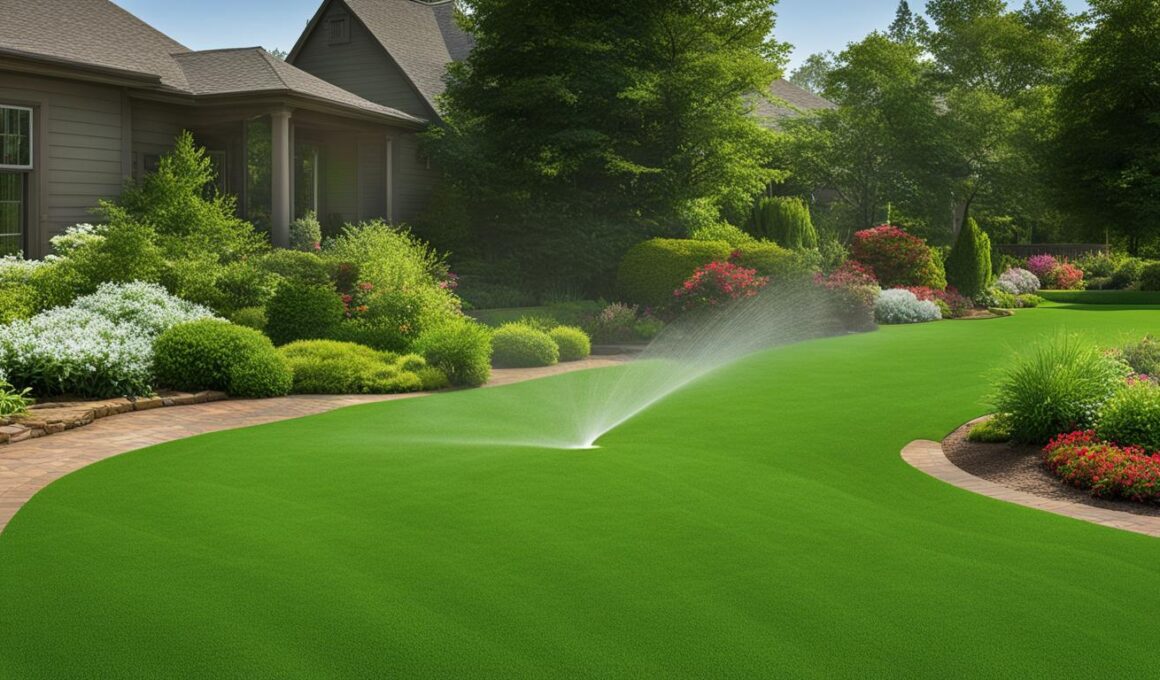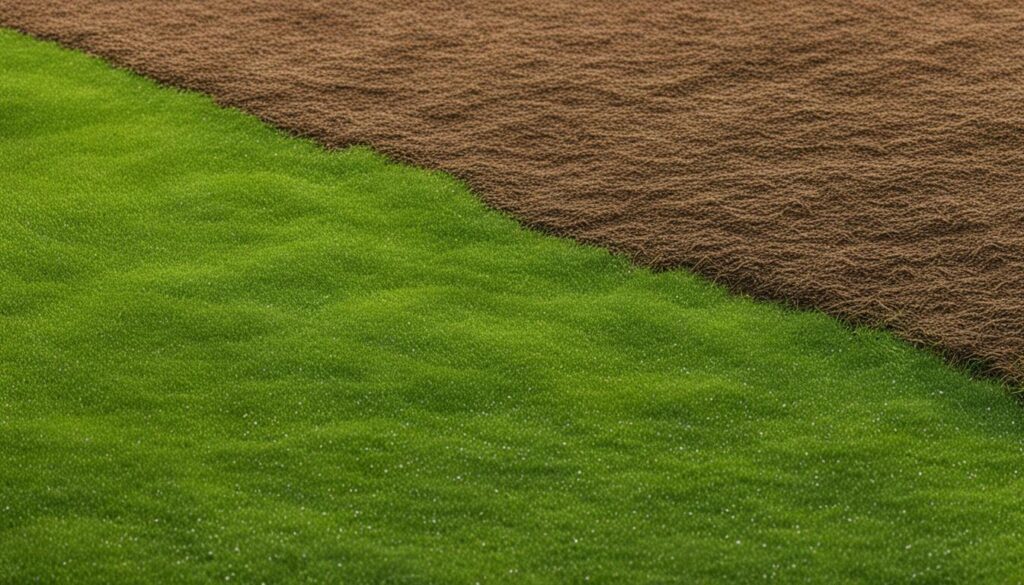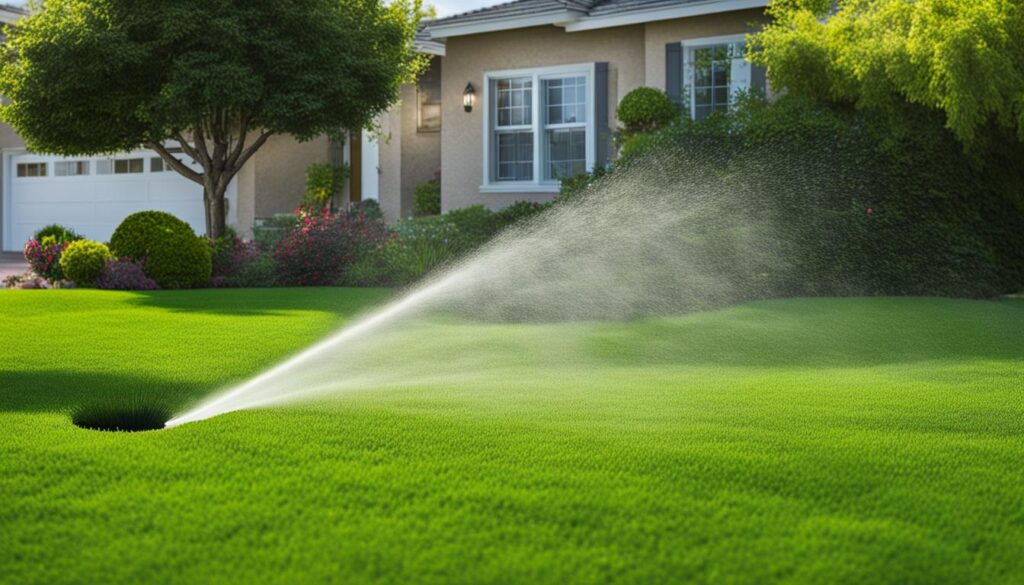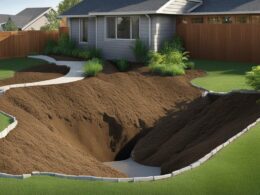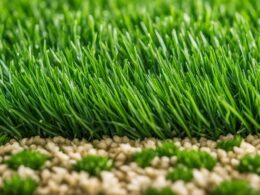Watering your lawn is crucial for maintaining its health and lush appearance. Improper watering can lead to issues such as disease, shallow root growth, and brown patches. According to experts, it’s important to water your lawn properly to ensure deep root growth and overall lawn health. Let’s explore how often you should water your lawn and the factors that influence watering frequency.
Key Takeaways:
- Proper watering is essential for a healthy and vibrant lawn.
- Factors such as shade, temperature, grass type, and soil drainage affect watering frequency.
- Cool-season and warm-season grasses have different watering needs.
- An established lawn typically needs 1 to 1.5 inches of water per week.
- Water in the morning or evening, and adjust watering time based on your sprinkler system.
Factors Affecting Lawn Watering Frequency
Several factors play a role in determining how often you should water your lawn. Understanding these factors will help you establish an appropriate watering schedule for your lawn.
1. Amount of Shade: The amount of shade your yard receives can affect the evaporation rate and water needs of your lawn. Shaded areas generally require less frequent watering compared to areas with direct sunlight.
2. Local Temperatures and Climate: Hotter and drier climates require more frequent watering, while cooler and more humid climates may need less water. Monitor weather conditions and adjust your watering schedule accordingly.
3. Wind Conditions: Wind can increase evaporation rates and cause uneven water distribution. Consider wind patterns and adjust your sprinkler system or watering schedule to compensate for windy conditions.
4. Grass Type: Different grass types have varying water requirements. Some grasses are more drought-tolerant and require less frequent watering, while others may need more frequent watering to thrive.
5. Age of Grass: Younger or newly established lawns typically require more frequent watering to promote root growth and development. As the grass becomes more established, watering frequency can be reduced.
6. Soil Type: Soil composition affects how well water is retained and absorbed. Sandy soils drain quickly and may require more frequent watering, while clay soils hold water longer and may need less frequent watering.
7. Size of Watering Zone: The size of your watering zone determines the amount of time needed to evenly distribute water. Larger zones may require longer watering times or multiple cycles to ensure proper coverage.
8. Soil Drainage: Good soil drainage is essential for preventing waterlogged areas and promoting healthy root growth. Poorly drained soils may require less frequent watering to prevent excessive moisture.
Recommended Watering Frequency for Different Grass Types
Watering frequency for your lawn depends on the type of grass you have. Different grass types have varying watering needs to maintain their health and vibrancy. By understanding the watering requirements of your specific grass type, you can ensure that your lawn receives the proper amount of water.
Cool-season grasses, such as fescue, rye, and bluegrass, require regular watering, especially during hot and dry periods. These grasses have higher water needs compared to warm-season grasses. To keep your cool-season lawn thriving, water it deeply and thoroughly, ensuring the soil is moist.
Warm-season grasses, including bermuda, St. Augustine, zoysia, and centipede grass, have lower water requirements and are more drought-tolerant. These grasses have adapted to survive in hotter and drier climates, making them more resilient during drought conditions.
When watering your warm-season grass, it’s important to let the soil dry out between watering sessions. This encourages deep root growth and makes the grass more resistant to drought. Watering too frequently can lead to shallow root growth and weaker grass.
By identifying the grass type in your lawn, you can tailor your watering schedule accordingly. Adhering to the recommended watering frequencies for your specific grass type will help you maintain a healthy and beautiful lawn.
How Much Water to Use and How to Measure it
When it comes to watering your lawn, using the right amount of water is crucial for maintaining its health and vitality. An established lawn typically requires 1 to 1.5 inches of water per week, which can come from either rainfall or irrigation. This amount of water allows for deep root growth and ensures your lawn can withstand dry periods.
To measure the amount of water your lawn receives, there are a few methods you can use. One common method is the screwdriver test. Simply push a screwdriver into the soil after watering, and if it goes in easily to a depth of 6 to 8 inches, then your lawn has received enough water. If not, you may need to adjust your watering time and frequency.
Another method involves math calculations based on the flow rate of your irrigation system. By measuring the water flow in gallons per minute and knowing the size of your lawn, you can calculate the time needed to achieve the desired amount of water. This method provides a more precise measurement but requires some initial setup and calculations.
If you prefer a simpler approach, you can use cans to measure the amount of water your lawn is getting. Place empty cans, such as tuna cans, throughout your lawn and run your sprinklers for a specific amount of time. Afterward, measure the water level in each can and calculate the average. This method gives you a rough estimate of the amount of water your lawn is receiving.
Using these measurement methods, you can adjust your watering time and frequency to ensure your lawn receives the appropriate amount of water. It’s important to find the right balance to avoid overwatering, which can contribute to issues like shallow root growth and disease, and underwatering, which can result in dry, brown patches on your lawn.
How Does Hydro Seeding Affect the Watering Needs of My Lawn?
Hydro seeding can significantly reduce the watering needs of your lawn. By using a slurry of seed, mulch, and water, the hydro seed cost understanding lawn landscapes process allows for better water retention and improved germination rates. This means less frequent watering and a healthier, more resilient lawn.
Best Practices for Watering Your Lawn
To effectively water your lawn and maintain its health and lush appearance, it’s important to follow some best practices. By implementing these tips, you can ensure that your lawn receives the proper amount of water and stays vibrant throughout the year.
Avoid watering your lawn during the hottest parts of the day, as the water will evaporate quickly. Instead, opt to water in the morning, preferably before 10 a.m. This allows the grass ample time to absorb the moisture before temperatures rise, ensuring optimal hydration for your lawn.
If morning watering isn’t feasible, you can water in the evening between 4 p.m. and 6 p.m. This timeframe allows the grass to dry before nighttime, reducing the risk of disease and promoting a healthy lawn. However, ensure that the grass has enough time to dry before sunset to prevent prolonged moisture retention.
Consider the type of sprinkler system you have when developing your watering schedule. Different sprinkler heads cover varying areas and require different watering times. Take into account the specific needs of your lawn and adjust your watering schedule accordingly to ensure even coverage and adequate hydration.
Lastly, it’s important to strike a balance between overwatering and underwatering. Both can have detrimental effects on your lawn’s health. Monitor your lawn regularly and adjust your watering schedule based on signs of thirst or excessive moisture. Look for visual cues such as wilting or browning grass, as well as spongey or overly dry soil. By paying attention to your lawn’s needs, you can prevent water wastage and maintain a vibrant, healthy lawn.





